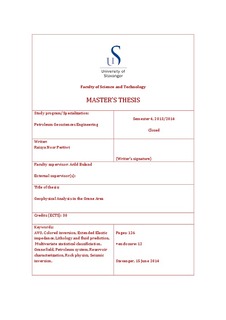| dc.contributor.author | Pertiwi, Raisya Noor | |
| dc.date.accessioned | 2014-12-18T11:55:12Z | |
| dc.date.available | 2014-12-18T11:55:12Z | |
| dc.date.issued | 2014-06-16 | |
| dc.identifier.uri | http://hdl.handle.net/11250/227798 | |
| dc.description | Master's thesis in Petroleum geology | nb_NO |
| dc.description.abstract | Conventional seismic stack are not very efficient to delineate the hydrocarbon bearing interval within the Lower Heimdal sandstones in the Grane area, as the reflectivity of top Lower Heimdal are subtle. This becomes more difficult as the wells are sparse and the sandstones have a complex distribution. This study suggests an improved structural mapping of top reservoir and an improved knowledge of the communication and distributions of hydrocarbon bearing interval. As an approach, this study develops a strategy of interpretation by using different seismic attributes. The seismic attributes are generated with and without involving the seismic inversion process by using near and far partial seismic stack. A cross-disciplinary analysis is also performed to justify the impact of lithology, pore-fluid saturation level, and petrophysical properties of the target interest, in the interpretation of seismic amplitudes with function of offset. This analysis includes well-log analysis, rock physics, AVO forward modeling, and multivariate statistical classification.
The analysis is also extended to quantify the level of sensitivity towards pore-fluid and lithology of different seismic data attributes. Using a right strategy for interpretation, by means of using a right seismic data attribute, one can obtain the information of pore-fluid, or lithology, or both of them; and reduce the probability of false misinterpretation. From all generated seismic reflectivity attributes, the gradient and the EEI reflectivity, provide the most reliable interpretation strategies for highlighting the top of Lower Heimdal sands. In terms of delineating hydrocarbon bearing sandstones, these attribute are also effective as well as the AVO Strength and the resulting impedance attributes given by seismic inversion. Together with the reflectivity attributes, the impedance attributes can provide a competent foundation to discriminate the oil-sandstones signature and to estimate the distribution of oil-sandstones bodies in 3D extent. | nb_NO |
| dc.description.sponsorship | Statoil ASA | nb_NO |
| dc.language.iso | eng | nb_NO |
| dc.publisher | University of Stavanger, Norway | nb_NO |
| dc.relation.ispartofseries | Masteroppgave/UIS-TN-IPT/2014; | |
| dc.subject | petroleumsteknologi | nb_NO |
| dc.subject | petroleumsgeologi | nb_NO |
| dc.subject | AVO | nb_NO |
| dc.subject | Grane field | nb_NO |
| dc.subject | lithology and fluid prediction | nb_NO |
| dc.subject | seismic inversion | nb_NO |
| dc.subject | colored inversion | nb_NO |
| dc.subject | petroleum system | nb_NO |
| dc.subject | rock physics | nb_NO |
| dc.subject | extended elastic impedance | nb_NO |
| dc.subject | reservoir characterization | nb_NO |
| dc.subject | multivariate statistical classificiation | nb_NO |
| dc.title | Geophysical analysis in the Grane Area | nb_NO |
| dc.type | Master thesis | nb_NO |
| dc.subject.nsi | VDP::Technology: 500::Rock and petroleum disciplines: 510::Geological engineering: 513 | nb_NO |
